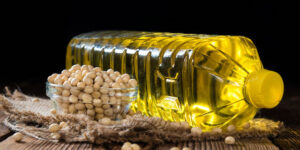
Study shows the most widely consumed edible oil in the US could be bad for the brain – and that oil from soybeans genetically engineered to be healthier is just as bad
People do not get very much information about fats and oils. Many people consume them every day but may not know if the kind they are consuming is good for their health. There are four different common oils (fats) that people consume. They are polyunsaturated oils, monounsaturated oils, regular saturated fats (oils), and highly saturated fats (oils). Many of them have some good points, but some may be harmful to your health.
The chemical structure of all fats (oils) is a chain of carbon atoms bonded to hydrogen atoms. The four main configurations, polyunsaturated, monounsaturated, regular saturated, and highly saturated fats react in the body in different ways.
Polyunsaturated and monosaturated oils are called essential oils that are a great help to a person if consumed every day. They are needed for defense against diseases, help lower blood pressure, prevent autoimmune diseases, help the immune system in many ways, construct cell membranes, coverings of nerves, and absorb some vitamins and minerals, plus very important, mixed with certain foods, will dissolve blood clots.
Most articles on fats do not mention that polyunsaturated and monounsaturated fats (oils) are made from raw, fresh, live vegetables, fruits, nuts, seeds, and fish. They have a bioelectric function needed for disease control, cell metabolism, cell membrane construction, blood metabolism, absorption of some vitamins and minerals, and many other essential body functions. Most nutritionists suggest that a person consume one to one and one-half tablespoons of essential poly or monounsaturated fats every day. My recommendation concerning some great fats is flaxseed oil, Udo’s choice, borage oil, northern seed oils, krill oil, fish oil, cod liver oil, and raw nut oils. My favorites are flaxseed oil and Udo’s choice. Udo’s choice is a combination of 6 different raw seed and nut oils. These oils need to be kept in the refrigerator.
Polyunsaturated and monounsaturated fats have a high electromagnetic mV value when kept cold and in the refrigerator. This is because they are mostly made from raw northern seeds, nuts, vegetables, fruits, olives, and fish. Many researchers and nutritionists have said that daily consumption of one to one and one-half tablespoons of these poly and monounsaturated fats each day, combined with other daily consumption of raw fresh, vegetables, fruits, nuts, berries, bulbs, leaves, and sprouts provide a great bioelectric diet which strengthens the immune system, creates energy, vitality, endurance, and possibly, longevity. Many alternative functional medicine physicians have stated that if a person starts young and consumes these essential fatty acids every day, they usually will have no arthritis, autoimmune diseases, and other diseases as well.
Most monounsaturated fats come mainly from raw olives, canola, peanuts, sesame seeds, salmon, mackerel, and flaxseeds. Olive oil was first discovered in the Mediterranean countries. The people who consumed a lot of olive oil (especially extra virgin olive oil), and fish oils reported that although they had a high-fat diet, they seldom had high blood pressure or heart disease. Please don’t get confused with cooking olive oil and extra virgin olive oil. Extra virgin olive oil is from raw olives and has a great electromagnetic energy value if kept in the refrigerator. Cooking olive oil has been boiled so it will not get rancid on the grocery shelf. It has no bioelectric value and will form transfats and mega trans.
Mono and polyunsaturated fats are also known as omega 3 fatty acids. Saturated fats are called omega 6 fatty acids. SATURATED fats are different from HIGHLY SATURATED fats. Both are known as omega 6 fatty acids. There is a great difference between the two sources. A normal BODY BLOOD RATIO of saturated fatty acids to omega 3 fatty acids is two to one or three to one.
Most regular saturated fatty acids have been boiled and have no bioelectric energy value source. When omega 6 fatty acids are heated in deep pots or frying pans, the blood ratio can be spiked up to 3o to 1 or even 4o to one. This may cause a condition known as sticky blood. This ratio may create homocysteine, a clotting factor in the blood. When people have high blood pressure and heart disease, this clotting factor can causes strokes, heart attacks, and blood clots in the veins. Dr. Catherine McGranahn, a Canadian heart specialist, took records on 250 high blood pressure and heart patients who were admitted to her hospital with a stroke, heart attack, or blood clot in the veins. She found that 80 percent of them had consumed saturated omega fats within 24 hours of being admitted to the hospital. The omega 6 to omega 3 ratio was over 30 to one in most patients.
Omega 3 fatty acids also protect a person against heart disease and blood clotting. Dr. Joanna Budwig in Germany used flaxseed oil (linolenic acid) to reduce clotting in cancer patients. I will discuss more about flaxseed oil later. They also reduce harmful LDL and cholesterol.
Saturated oils are oils that are fully saturated with hydrogen atoms which are more in number than mono and polyunsaturated fats. There are two classifications, highly saturated and regular saturated fats. To explain regular saturated fats, we need to look at the unrefrigerated saturated fats on the grocery shelf, except extra virgin olive oil. These fats and oils have been boiled to 360 degrees and have no electromagnetic energy value. They have flunked the health test. They are overrefined, many GMO, bioelectric (dead) oils. Some of these are corn oil, soybean oil, safflower oil, canola, and cottonseed oil. Also, when heated, saturated fats change to transfats and mega trans, both of which are very harmful to your health. High blood pressure and heart disease patients should avoid regular saturated fats. The problem is that many fast-food restaurants and other eating places use these regular saturated fats because they are cheap. Deep-fried french fries, chicken, fish, doughnuts, chips, some bagels, and many other fast food items are filled with saturated oils. It is wise not to consume these potential blood clotting saturated oils when electromagnetic poly and monounsaturated fats are available.
The exception is with highly saturated fats used for cooking. Many nutritionists say that coconut oil, palm oil, and butter (highly saturated fats) are the best oils for cooking since the molecular formula changes very little when heated.
There is one combination of flaxseed oil that I would recommend for consuming every day. The Budwig cancer clinic uses a flaxseed oil, cottage cheese, Quark, and crushed flaxseed mixture that they give every day to their cancer patients. Dr. Budwig found that about 80 percent of cancer patients had what can be called “sticky” blood. That is blood that is coagulated and clots easily. This combination of “sticky blood” coagulation can also occur in people with high blood pressure and heart disease.
My wife and I use this flaxseed combination every day as a preventive measure against having any clotting factor in our blood. There is a good chance that it is helping to keep our blood pressure low, which is great. It also gives us a chance to consume some wonderful electromagnetic food for breakfast.
This is our combination: Do not compare this to the effectiveness of the Budwig formula if you have cancer. But it contains some very good electromagnetic energy boosters. It begins with two heaping tablespoons of 2 percent cottage cheese. Two tablespoons of flaxseed oil, 3 tablespoons of quark, and two heaping tablespoons of crushed flaxseeds, crushed in a coffee grinder. I then add 1/2 cup of raw almonds, walnuts, and pecans. Next, in goes 4 or 5 cloves of garlic, crushed in a garlic crusher. Lastly, I add 1/2 cup of fresh or frozen blueberries. Sometimes I have to add a little almond milk to thin the mixture. That is it.
July 24, 2021
~ the Author ~
Merle E. Loudon, B.S., D.D.S. graduated from the University Of Washington School Of Dentistry in 1957. After two years of service in the Air Force, he started a private practice in East Wenatchee, Washington. For the past 45 years his practice has included Orthodontics and TM Dysfunction treatment specializing in temporomandibular pain treatment, headache, head and neck pain control, functional jaw orthopedics, and straight wire orthodontics. Associated with mercury elimination, oral surgery, crowns and bridges is TMJ treatment, diet control, parasite elimination, intestinal cleansing and healing (wellness).
 Merle E. Loudon, B.S., D.D.S. has taught advanced courses for dentists on TM Dysfunction treatment, orthodontics and related pain control for more than 30 years. In 1972 he was the first dentist in Washington to use straight wire orthodontics and the first dentist to correct vertical deficiencies in children by placing vertical dimension-primary molar buildups and/or vertical (erupting) appliances. Merle E. Loudon, B.S., D.D.S. was involved with the first group of dentists to recognize lateral tongue splinting in young infants and integrate functional and fixed techniques to correct vertical dimension deficiencies and condylar placement. He is the originator of vertical dimension-primary molar build ups, which help to correct deep bites and Otitus media in children. He invented the Loudon-Chateau Anterior Repositioning Appliance, the functional muscle malocclusion concept, the twelve commandments of occlusion and the vertical overbite domino rule. Merle E. Loudon, B.S., D.D.S. has written numerous articles in several American and foreign dental journals and has lectured in over 50 cities and 7 foreign countries on functional jaw orthopedics, fixed wire orthodontics, Otitus media treatment and TM Dysfunction treatment. He has been instrumental in setting up criteria for teaching in the International Association For Orthodontics, including the certified instructor program.
Merle E. Loudon, B.S., D.D.S. has taught advanced courses for dentists on TM Dysfunction treatment, orthodontics and related pain control for more than 30 years. In 1972 he was the first dentist in Washington to use straight wire orthodontics and the first dentist to correct vertical deficiencies in children by placing vertical dimension-primary molar buildups and/or vertical (erupting) appliances. Merle E. Loudon, B.S., D.D.S. was involved with the first group of dentists to recognize lateral tongue splinting in young infants and integrate functional and fixed techniques to correct vertical dimension deficiencies and condylar placement. He is the originator of vertical dimension-primary molar build ups, which help to correct deep bites and Otitus media in children. He invented the Loudon-Chateau Anterior Repositioning Appliance, the functional muscle malocclusion concept, the twelve commandments of occlusion and the vertical overbite domino rule. Merle E. Loudon, B.S., D.D.S. has written numerous articles in several American and foreign dental journals and has lectured in over 50 cities and 7 foreign countries on functional jaw orthopedics, fixed wire orthodontics, Otitus media treatment and TM Dysfunction treatment. He has been instrumental in setting up criteria for teaching in the International Association For Orthodontics, including the certified instructor program.
Dr. Loudon is a member of The American Dental Association, Diplomat and Senior Instructor in the International Association for Orthodontics, and is a Diplomat of the American Academy of Pain Management. He also is a member of the American Orthodontic Society.
